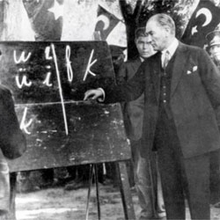
On November 1, 1928, the new Turkish alphabet was introduced by the Language Commission at the initiative of Atatürk, replacing the previously used Perso-Arabic script.
Ankara / NationalTurk – The adoption of the Latin alphabet and the purging of foreign loanwords was part of Mustafa Kemal Atatürk’s (founder and first president of Turkish Republic) program of modernization. And Turkey recently celebrates its 79th Dil Bayramı, or Language Holiday, and 83th anniversary of Alphabet Reform.
The dismissal of Arabic script was defended on the ground that it was not appropriate for the authentic Turkish phonology, which needs a new set of symbols to be correctly represented. The Ottoman Perso-Arabic script was an abjad, which made it too ambiguous for the Turkish language, in which vowels are far more important than in Arabic. A well-known example of the deficiency of the Arabic script is the phrase محمد پاشا اولدو, which can represent either Mehmet Paşa oldu (Muhammad became a Pasha) or Mehmet Paşa öldü (Muhammad Pasha died). Ottoman writers had to work around such ambiguities via circumlocutions, usually of Persian or Arabic origin.
Adoption of new Turkish alphabet and purification of Turkish language from foreign words
The abandonment of the chotic Arabic script was not merely a symbolic expression of secularization by breaking the link to Ottoman Islamic texts to which only a minor group of ulema (teaching class in the religion based schools) had access; but also Latin script would make reading and writing easier to learn and consequently improve the literacy rate.
In the years after the War of Independence, Mustafa Kemal Atatürk inaugurated a decades-long campaign to get rid Turkish of its centuries-old confusing Persian and Arabic heritage. Turkish was switched from the Arabic to the Latin alphabet in 1928, and in 1932, the Turkish Language Association (TDK) was founded to oversee the development of a new national vocabulary based on the ‘historic Turkishness’ of the language.
Turkish Language Reform : One of Mustafa Kemal Atatürk ‘s invaluable reforms
With the establishment of the republic, Atatürk made language reform an important part of the nationalist program. The goal was to produce a language that was more Turkish and less Arabic, Persian, and Islamic; one that was more modern, practical, and precise, and less difficult to learn. The republican language reform called for a drastic alteration of both the spoken and the written language. This process was to be accomplished through two basic strategies–adoption of a new alphabet and purification of the vocabulary.
The language revolution officially began in May 1928, when numbers written in Arabic were replaced with their Western equivalents. In November the Grand National Assembly approved a new Latin alphabet that had been devised by a committee of Turkish scholars. Many members of the assembly favored gradually introducing the new letters over a period lasting up to five years. Atatürk, however, insisted that the transition last only a few months, and his opinion prevailed. With chalk and a portable blackboard, he traveled throughout Turkey giving writing lessons in the new Latin alphabet in schools, village squares, and other public places to a people whose illiteracy rate was suddenly 100 percent. On January 1, 1929, it became unlawful to use the Arabic alphabet to write Turkish.
[adrotate banner=”33″] Donald Trump says Zelensky ‘come back when he is ready for Peace’
Donald Trump says Zelensky ‘come back when he is ready for Peace’ Turkey Arrests Three Opposition Journalists
Turkey Arrests Three Opposition Journalists Heatwave: Türkiye is roasting!
Heatwave: Türkiye is roasting! Flixbus accident on A9: Five dead, many injured – hospitals alerted
Flixbus accident on A9: Five dead, many injured – hospitals alerted